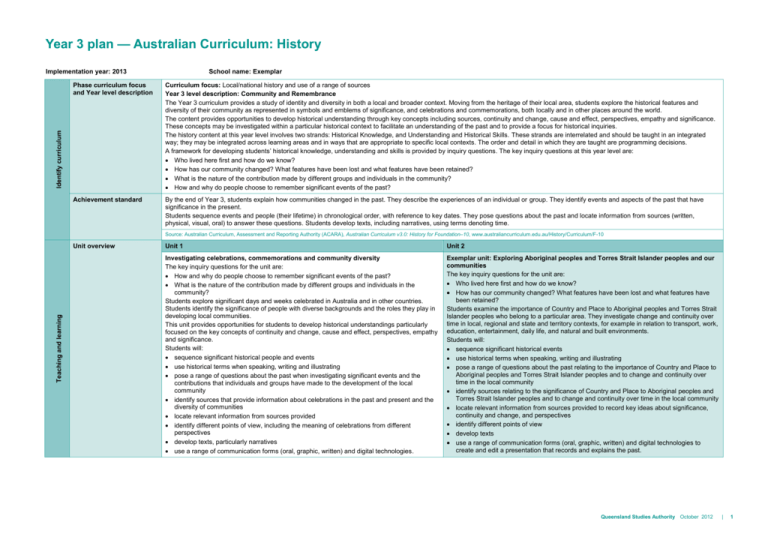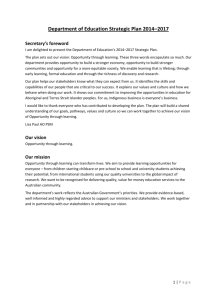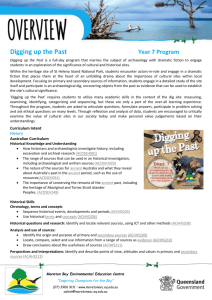Year 3 plan - Queensland Curriculum and Assessment Authority
advertisement

Year 3 plan — Australian Curriculum: History Implementation year: 2013 School name: Exemplar Curriculum focus: Local/national history and use of a range of sources Year 3 level description: Community and Remembrance The Year 3 curriculum provides a study of identity and diversity in both a local and broader context. Moving from the heritage of their local area, students explore the historical features and diversity of their community as represented in symbols and emblems of significance, and celebrations and commemorations, both locally and in other places around the world. The content provides opportunities to develop historical understanding through key concepts including sources, continuity and change, cause and effect, perspectives, empathy and significance. These concepts may be investigated within a particular historical context to facilitate an understanding of the past and to provide a focus for historical inquiries. The history content at this year level involves two strands: Historical Knowledge, and Understanding and Historical Skills. These strands are interrelated and should be taught in an integrated way; they may be integrated across learning areas and in ways that are appropriate to specific local contexts. The order and detail in which they are taught are programming decisions. A framework for developing students’ historical knowledge, understanding and skills is provided by inquiry questions. The key inquiry questions at this year level are: Who lived here first and how do we know? How has our community changed? What features have been lost and what features have been retained? What is the nature of the contribution made by different groups and individuals in the community? How and why do people choose to remember significant events of the past? Achievement standard By the end of Year 3, students explain how communities changed in the past. They describe the experiences of an individual or group. They identify events and aspects of the past that have significance in the present. Students sequence events and people (their lifetime) in chronological order, with reference to key dates. They pose questions about the past and locate information from sources (written, physical, visual, oral) to answer these questions. Students develop texts, including narratives, using terms denoting time. Identify curriculum Phase curriculum focus and Year level description Source: Australian Curriculum, Assessment and Reporting Authority (ACARA), Australian Curriculum v3.0: History for Foundation–10, www.australiancurriculum.edu.au/History/Curriculum/F-10 Teaching and learning Unit overview Unit 1 Unit 2 Investigating celebrations, commemorations and community diversity The key inquiry questions for the unit are: How and why do people choose to remember significant events of the past? What is the nature of the contribution made by different groups and individuals in the community? Students explore significant days and weeks celebrated in Australia and in other countries. Students identify the significance of people with diverse backgrounds and the roles they play in developing local communities. This unit provides opportunities for students to develop historical understandings particularly focused on the key concepts of continuity and change, cause and effect, perspectives, empathy and significance. Students will: sequence significant historical people and events use historical terms when speaking, writing and illustrating pose a range of questions about the past when investigating significant events and the contributions that individuals and groups have made to the development of the local community identify sources that provide information about celebrations in the past and present and the diversity of communities locate relevant information from sources provided identify different points of view, including the meaning of celebrations from different perspectives develop texts, particularly narratives use a range of communication forms (oral, graphic, written) and digital technologies. Exemplar unit: Exploring Aboriginal peoples and Torres Strait Islander peoples and our communities The key inquiry questions for the unit are: Who lived here first and how do we know? How has our community changed? What features have been lost and what features have been retained? Students examine the importance of Country and Place to Aboriginal peoples and Torres Strait Islander peoples who belong to a particular area. They investigate change and continuity over time in local, regional and state and territory contexts, for example in relation to transport, work, education, entertainment, daily life, and natural and built environments. Students will: sequence significant historical events use historical terms when speaking, writing and illustrating pose a range of questions about the past relating to the importance of Country and Place to Aboriginal peoples and Torres Strait Islander peoples and to change and continuity over time in the local community identify sources relating to the significance of Country and Place to Aboriginal peoples and Torres Strait Islander peoples and to change and continuity over time in the local community locate relevant information from sources provided to record key ideas about significance, continuity and change, and perspectives identify different points of view develop texts use a range of communication forms (oral, graphic, written) and digital technologies to create and edit a presentation that records and explains the past. Queensland Studies Authority October 2012 | 1 Teaching and learning Aboriginal and Torres Strait Islander perspectives History provides opportunities for students to strengthen their appreciation and understanding of Aboriginal peoples and Torres Strait Islander peoples and their living cultures. Specific content and skills within relevant sections of the curriculum can be drawn upon to encourage engagement with: Aboriginal and Torres Strait Islander frameworks of knowing and ways of learning Indigenous contexts in which Aboriginal and Torres Strait Islander peoples live Aboriginal peoples’ and Torres Strait Islander peoples’ contributions to Australian society and cultures. The Australian Curriculum: History values Aboriginal and Torres Strait Islander histories and cultures. For Aboriginal and Torres Islander students, it provides an opportunity to see themselves within the curriculum and in an educational setting that respects and promotes their cultural identities. Students are taught that Australian Aboriginal societies are the longest surviving societies in the world and that Aboriginal and Torres Strait Islander peoples are two distinct groups. Students learn about Aboriginal and Torres Strait Islander occupation of the continent prior to colonisation by the British, and the ensuing contact and conflict between these societies. Students develop an awareness of the resilience of Aboriginal peoples and Torres Strait Islander peoples and the ways in which their expertise and experiences in contemporary science, education, the arts, sport and tourism; their inventions; and their knowledge of medicine have contributed to the development of a culturally diverse Australian society. General capabilities and cross-curriculum priorities Opportunities to engage with: Key to general capabilities and cross-curriculum priorities Literacy Numeracy Opportunities to engage with: ICT capability Critical and creative thinking Aboriginal and Torres Strait Islander histories and cultures Make judgments and use feedback Develop assessment Assessment For advice and guidelines on assessment, see: www.qsa.qld.edu.au 2 | Moderation Year 3 plan Australian Curriculum: History Personal and social capability Asia and Australia’s engagement with Asia Ethical behaviour Intercultural understanding Sustainability The following assessment will provide a targeted selection of evidence of student learning across different assessment techniques and instruments. This evidence will be collected in a folio to make an overall on-balance judgment about student achievement and progress at appropriate points, and to inform the reporting process. Unit 1 Unit 2 Assessment Assessment Collection of work (Written) The purpose of this assessment is to make judgments about students’ responses to a series of focused tasks within a specified context and based on the process of historical inquiry. The focus of the collection of work is on celebrations and commemorations and could include: written explanations questions of, and responses to, source material annotated timelines graphic organisers debates or discussions (with notes) physical/visual artefacts annotated photographs re-enactments and roleplays. Collection of work (Written) The purpose of this assessment is to make judgments about students’ responses to a series of focused tasks within a specified context and based on the process of historical inquiry. The focus of the collection of work is cause and effect, and continuity and change in communities and could include: written explanations questions of, and responses to, source material annotated timelines journal entries annotated photographs physical/visual artefacts. Research: Response (Written, multimodal) The purpose of this assessment is to make judgments about students’ abilities to research, collect, analyse and draw conclusions about historical sources. Students explore the contributions of a person or group in their local community. They use a range of sources to find out about the influence and contributions of that person or group in the development of their local community. Students pose questions, identify sources and locate relevant information from provided sources. They identify different points of view using a range of communication forms. Research: Presentation (Spoken/signed, multimodal) The purpose of this assessment is to make judgments about students’ abilities to research, collect, analyse and draw conclusions about historical sources. Students create a presentation about a place that has significance to Aboriginal or Torres Strait Islander communities. They investigate why and how Aboriginal peoples and Torres Strait Islander peoples associate with the land and sea in stories and events. Teachers develop tasks and plan units. Teachers co-mark tasks to ensure consistency of judgments. Teachers develop tasks and plan units. Teachers calibrate A–E samples of student work that link to the standards before marking tasks. They moderate to ensure consistency of judgments. Teachers select representative folios and meet to ensure consistency of judgments before marking tasks. Year 3 History: review for balance and coverage of content descriptions, including emphasis on historical understandings Historical Knowledge and Understanding Historical Knowledge 1 2 Community and Remembrance The importance of Country and Place to Aboriginal and/or Torres Strait Islander peoples who belong to a local area. (This is intended to be a local area study with a focus on one Language group; however, if information or sources are not readily available, another representative area may be studied) (ACHHK060) ONE important example of change and ONE important example of continuity over time in the local community, region or state/territory; for example, in relation to the areas of transport, work, education, natural and built environments, entertainment, daily life (ACHHK061) Historical Skills Historical Understandings1 The key concepts of historical understanding are: 1 2 Historical Skills Sources Written or non-written materials that can be used to investigate the past. A source becomes “evidence” if it is of value to a particular inquiry. Chronology, terms and concepts 1 2 Sequence historical people and events (ACHHS065) Use historical terms (ACHHS066) Pose a range of questions about the past (ACHHS067) Identify sources (ACHHS215) Develop texts, particularly narratives (ACHHS070) Use a range of communication forms (oral, graphic, written) and digital technologies (ACHHS071) Historical questions and research Continuity and change Continuities are aspects of the past that have remained the same over certain periods of time. Changes are events or developments from the past that represent modifications, alterations and transformations. Analysis and use of sources Locate relevant information from sources provided (ACHHS068) Perspectives and interpretations The role that people of diverse backgrounds have played in the development and character of the local community (ACHHK062) Cause and effect The relationship between a factor or set of factors (cause/s) and consequence/s (effect/s). These form sequences of events and developments over time. Identify different points of view (ACHHS069) Explanation and communication Days and weeks celebrated or commemorated in Australia (including Australia Day, ANZAC Day, Harmony Week, National Reconciliation Week, NAIDOC week and National Sorry Day) and the importance of symbols and emblems (ACHHK063) Perspectives A point of view or position from which events are seen and understood, and influenced by age, gender, culture, social position and beliefs and values. Celebrations and commemorations in other places around the world; for example, Bastille Day in France, Independence Day in the USA, including those that are observed in Australia such as Chinese New Year, Christmas Day, Diwali, Easter, Hanukkah, the Moon Festival and Ramadan (ACHHK064) Empathy An understanding of the past from the point of view of the participant/s, including an appreciation of the circumstances faced, and the motivations, values and attitudes behind actions. Significance The importance that is assigned to particular aspects of the past, such as events, developments, movements and historical sites, and includes an examination of the principles behind the selection of what should be investigated and remembered. Source: Australian Curriculum, Assessment and Reporting Authority (ACARA), Australian Curriculum v3.0: History for Foundation–10, www.australiancurriculum.edu.au/History/Curriculum/F-10 1 The historical understandings are derived from the content descriptions and achievement standards, and are supported by Historical Skills. The Year level description provides information about the development of historical understandings through key concepts. The definitions of historical understandings are based on the glossary terms published in Australian Curriculum v3.0: History for Foundation-10, www.australiancurriculum.edu.au/History/Curriculum/F-10. Queensland Studies Authority October 2012 | 3






